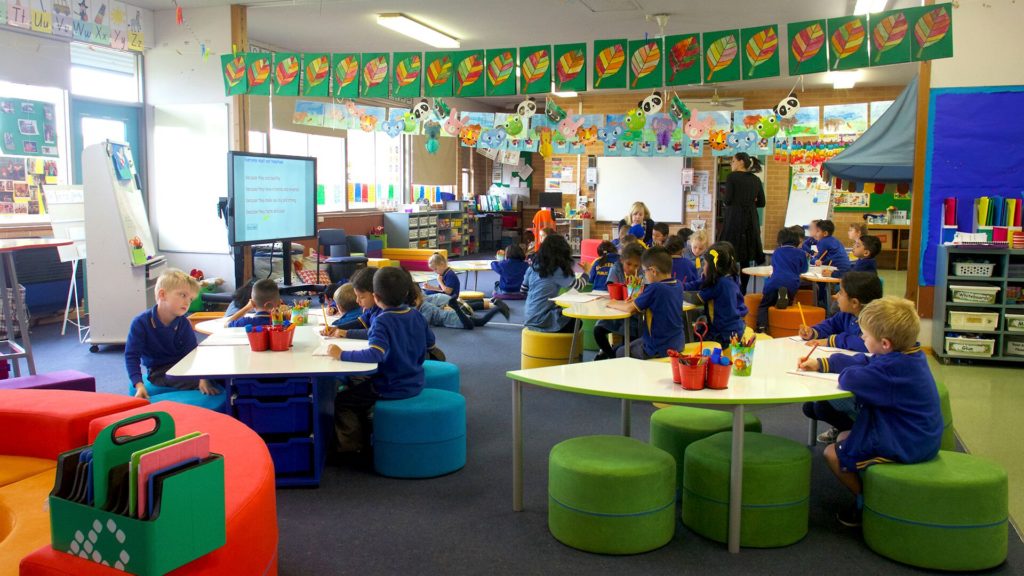Quakers Hill Public School is situated in a fast growing suburb. The elementary school has grown to house nearly a thousand students. However, as the school has evolved, so too has its curriculum and approach to learning environments, with a focus on increasing student engagement. They wanted to change things up to create a 21st century school that is suitable for all students.
The school’s principal Bert Lo Campo is recognised as an innovator and a future-focused thinker. Under his leadership, the school is constantly looking for the next thing to encourage growth of the children. Over recent years, many of the 38 classrooms have evolved from traditional classrooms to flexible learning spaces for future-focused learning.
Vice Principal Chris Lambert from Quakers Hill Public School explained that the biggest challenge has become engaging students in the classroom. Whereas decades ago, students were expected to sit in rows and listen quietly, educators today are vying for their attention. With the need to effectively deliver a focused curriculum to enable these future job seekers with 21st century skills, classrooms that are not conducive to engagement are doing a disservice to students. It wasn’t a case of just rearranging existing furniture, but creating learning spaces that are inherently flexible and adaptable to suit different students’ needs and the needs of the learning content.
“Students want the next thing, they want the newest thing, they want something to really inspire and engage,” Mr. Lambert said. “Where twenty to thirty years ago the children would go to school, they would sit there all very quiet, they would sit in their rows. Now, we’re vying for their engagement because there are so many different things in the community, in society that engage them and distract them. The nature of what we do is make sure that those children are engaged first and foremost. Because it doesn’t matter what quality of curriculum you deliver, if they’re not engaged in the practices that you’re delivering, it counts for nothing.”
As Mr. Lambert further states, “The jobs that we’re preparing our children for now, a huge percentage of them haven’t even been created or developed yet. And so the school has to be adaptable, replaceable skills that we need to develop under the 21st century skill set model. We need obviously to change our pedagogy to adapt to that. But we also need a learning space that caters to that teaching style and to that pedagogy as well. So it’s not just a matter of saying, “We’ve got the same desks. Let’s just rearrange them into a horseshoe.”
“It’s about creating furniture that is flexible and adaptable, that works for us, that we can change based on our needs, based on the student needs, based on the content that we’re teaching,” Lambert said. “One of the big evolutions in our thinking in relation to the furniture is that it needs to be multipurpose. That’s one of the things that I was first drawn to with the NorvaNivel furniture. You go from the traditional thinking, this is a desk, it serves the function of a desk. NorvaNivel have taken it to that next step where you’ve got the flip tables where it’s now a table that they can write on and that they can lean on and use in all the traditional ways, but then they can flip it up, it becomes a display for the rest of the class.
“[What] I love about a lot of the furniture is the thought that goes behind it and the rationale behind it. It’s what the children like, what they need,” he said. “You know, they have the option to stand. They have the option to sit at a stool. They have the option to lie on the floor. They have the option to lie on an ottoman and work that way. And by giving them those choices, you allow them to then be comfortable and focus on the task at hand and focus on the skills you’re trying to teach them.”
“It’s been really, really good to work with the designers from NorvaNivel,” stated Mr. Lambert. “It’s a very professional organisation. The designers will put something together and say, “Well, here is what it will actually look like”, three dimensional sketches and all the rest of it. We could look at what was going to happen and look at what we were going to get in the classrooms. And then we would feedback. The response is never, “I don’t think we can do that.” The response is always, “No problem.” And it comes straight back.
“We’ve had six spaces done this year all through NorvaNivel and all six of them are unique in their own way. That’s a different space and that’s a different feel and I think a lot of that comes through the negotiation from each individual teacher working with the NovaNivel design team. Every step of the way it’s been wonderful.”
NorvaNivel furniture has been used to transform numerous classrooms into 21st century learning spaces. Their ideas and creations allow for students to have an ultimate learning experience by changing the traditional environment around them. Educators will be able to create a space with classroom furniture designed by NorvaNivel that will work with all different types of student learners.

